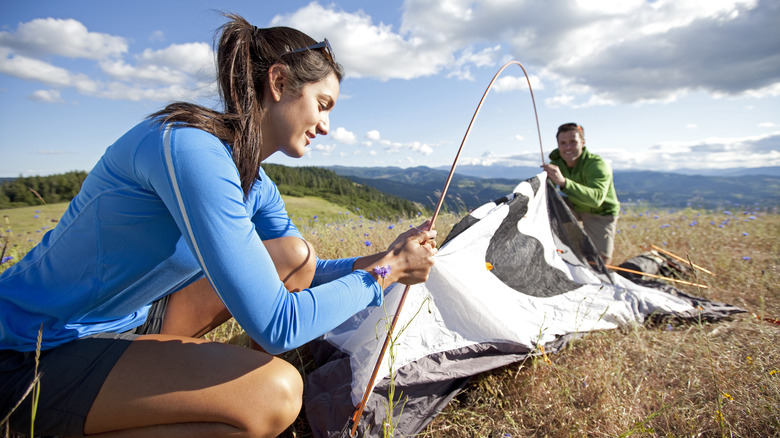Scout your spot for level, not-rocky ground
As freelance writer Heather Balogh Rochfort has found through her wilderness experience, the most convenient locations might not be ideal for rest. “You’ll want to avoid sites around the bathrooms and other public areas. If you’re close to these buildings, you’ll have people walking by your tent at all hours of the night,” she noted (via Sleep). Finding this exact spot to set up your tent/sleeping area is crucial to sleeping comfortably.
The ground should be clear of rocks and debris, so as not to be painful to walk or sleep on. You should also keep in mind the size of your tent in comparison to the site itself and other external factors such as the fire and shade under trees. Scouting out your sleeping spot is especially important if you are hiking up slopes and hills. If you need to pitch your sleeping area on a slope, you can choose either parallel or perpendicular to the slope.
Parallel orientation stops you from rolling out of bed or waking up with a pounding headache, while perpendicular requires a bit more effort to pad the bottom of the tent to stay level. Resting on a slope might also mean your gear or tent could slide or slip, though. A good way to prevent too much movement is to use outdoor-grade slip tape, like this one from Amazon, to hold things in place, especially if you tend to move around a lot at night.
Try using a hammock to sleep in
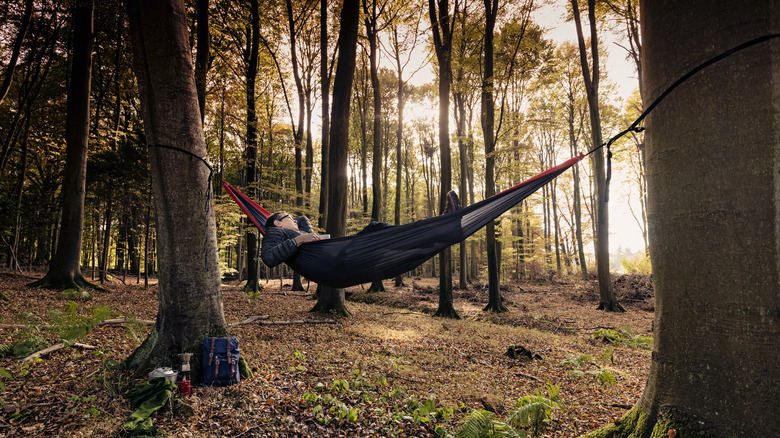
Hammocks are more than just fun backyard furniture. Not only can you bring a hammock camping, but research shows that sleeping in one could give you the best chance of getting a restful night’s sleep. Sleep researchers had subjects try sleeping in hammocks to see the effects of motion/rocking back and forth while trying to rest. According to NPR, the results found that rocking increased the length of N2 sleep, a type of non-REM sleep, as well as increased “sleep spindles,” i.e. brain activity that is associated with tranquil sleep in noisy environments.
While sleeping in a hammock is restful, what can be stressful is figuring out how to get into it. Luckily the setup and self-orientation are quite easy to remember. Avid hammock users pointed out that the biggest mistake people make is pulling it too tightly so the hammock sits flatter. Because of the nature of hammocks, any weight placed inside will sink down and form a tight cocoon, which makes it difficult to get comfortable. The right way to sleep flat in a hammock is to sit/lay down diagonally and to keep a light tautness so that the angle of your sag is 30 degrees or more.
Bring a sleeping pad and sleeping bag
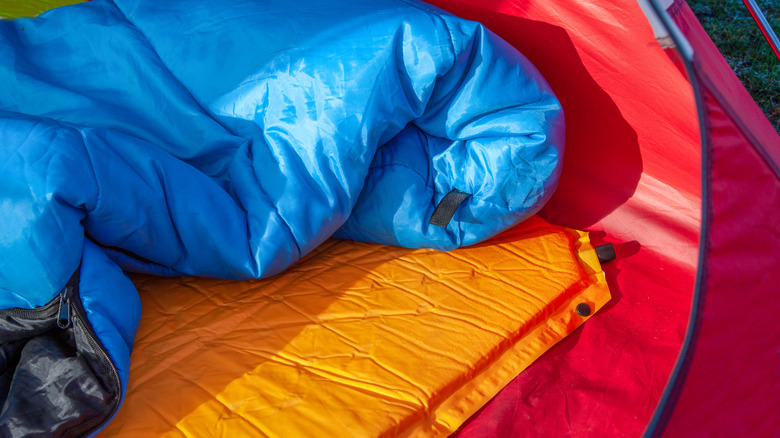
Ashley-belle Burns/Getty Images
To figure out what sleep gear to bring or buy, you should first have a pretty good idea about how you sleep best at home. Before deciding on the individual pieces, be sure to budget to purchase both a sleeping pad and a sleeping bag that fits your needs. As winter trekker Emily Ford informed CNN, “The pricier brands are, generally the more true to their temperature ratings. If you can save up the money for a great bag, your trip options are limitless.”
The combination of both pad and bag will not only ensure you get some good rest but these items will be used time and time again. As many commenters on Reddit’s Camping Gear thread noted, these pieces work in collaboration with each other. The pad provides insulation between you and the ground, while the bag insulates the space directly around you. Without the pad, the temperature of the ground affects you directly, which is not ideal.
Temperature will also determine what type of sleeping bag you need. If you run hot you might benefit from a better insulating material, such as a down-filled sleeping bag as opposed to synthetic. This applies to the sleeping pads as well, which are given an R-value rating based on the pad’s warmth. The lower ratings, R1-R2, are best used during summertime, whereas anything R6 and above is more suited to extremely cold temperatures.
Don’t forget a pillow, plus an extra for side sleepers
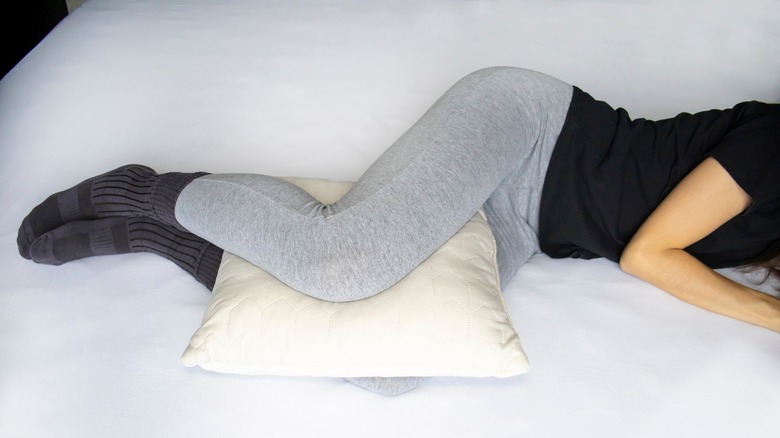
Zaruna/Shutterstock
After long days exploring and exhausting oneself the support to your neck and shoulders that a pillow offers is imperative. The pillow beneath your head should have enough support to keep the head, neck, and spine in alignment, as registered nurse/sleep educator Terry Cralle advised The New York Times. For camping, it’s important to pack at least one pillow sturdy enough for the journey. And for those who are side sleepers, an extra pillow added to your pack can give you even more support to get some much-needed rest.
Sleeping on one’s side is not only preferred by plenty of adults, but it can also be beneficial on a camping trip. From sleep apnea and digestion issues to less snoring and back pain, side sleeping has many great health benefits. Placing an extra pillow between your knees or legs has been proven to be an ingenious move for side sleeping. As Cralle asserted, “A thinner pillow placed between your knees can help make you more comfortable and help keep your spine in a neutral position.”
There are plenty of different knee pillow types available depending on your specific needs, even ones specifically designed for pregnant people. However, if remembering that extra pillow escapes the planning process, it’s easy to roll up a jacket or blanket to act as a between-the-knees pillow while camping.
Bring pajamas/sleeping clothes
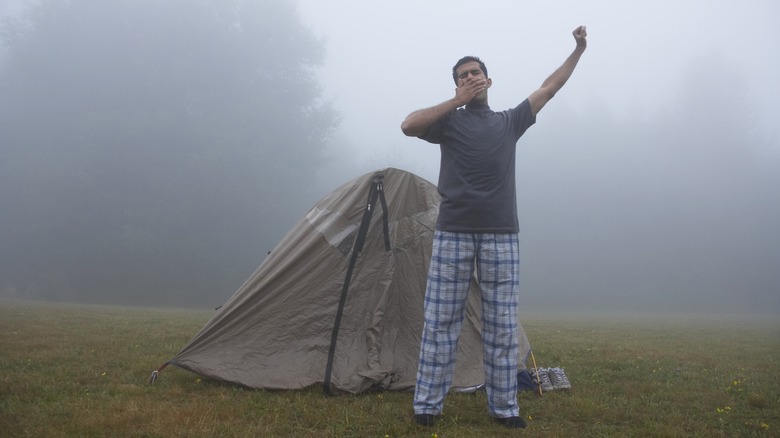
Dave & Les Jacobs/Getty Images
No matter the season, it’s important to dress for the weather and be prepared for any changes when camping. This thinking applies to both what you wear when trekking around the great outdoors and what you wear when it’s time for bed. Day clothes should be made for adventuring: Thinner layers and breathable fabrics like synthetics for jackets and wool for cooler weather. At night, meanwhile, what you wear to bed can affect how restful your sleep is.
Folklore might suggest that wearing less clothing (or nothing at all) is the ideal way to sleep. However, experienced campers know this to only work in emergency situations when your clothes are soaked from rain/water. It’s important to carry separate clothes to sleep in for this exact reason, so the dampness of either precipitation or your perspiration will not affect your body temperature.
Temperature is key when picking your pajamas, as you’ll want pieces that are warm but not too heavy — otherwise, you’ll be stripping off layers throughout the night. To help you sleep during the colder months, you can also add a hat to your pajama set, as a lot of body heat is lost from the head. A hat helps trap the heat and keep it close.
Hydrate wisely
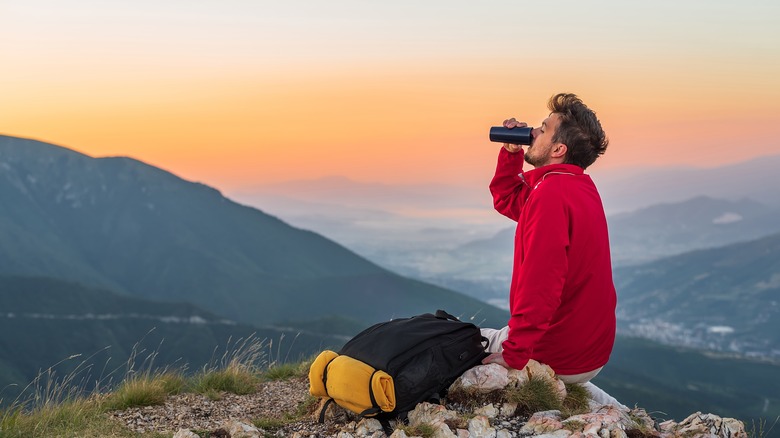
MalikNalik/Shutterstock
Hydration is important to keep in mind when adventuring outdoors. Depending on your activities, it is also essential to monitor how much water/fluids to drink so as to keep your body and mind in balanced health. Dehydration can be detrimental on any camping trip, as your weakened body, when pushed to stay active and moving, can put you at risk of heat stroke, exhaustion, or even collapse. Hydrating properly throughout the day, and particularly before bed, will ensure you’re ready to get up and go in the morning and ensure you sleep comfortably too.
Proper hydration should be consistent throughout the day, then finishing in the early evening so as not to disrupt your sleep cycle. This can be done while setting up camp for the night or while you prepare/cook dinner. If you are worried that you might not be adequately hydrating or feel yourself needing a boost, you can enhance your water intake with an electrolyte additive at this time.
This can be ideal for summer/hot weather hiking. A good way to know the status of your hydration levels is to monitor your urine, checking that the color is clear and light. Reaching these levels should be a goal, but don’t try to over-compensate by drinking too much water. Especially at higher altitudes, doing so can throw your sodium levels out of balance, causing confusion, dizziness, and even seizures.
Secure food correctly
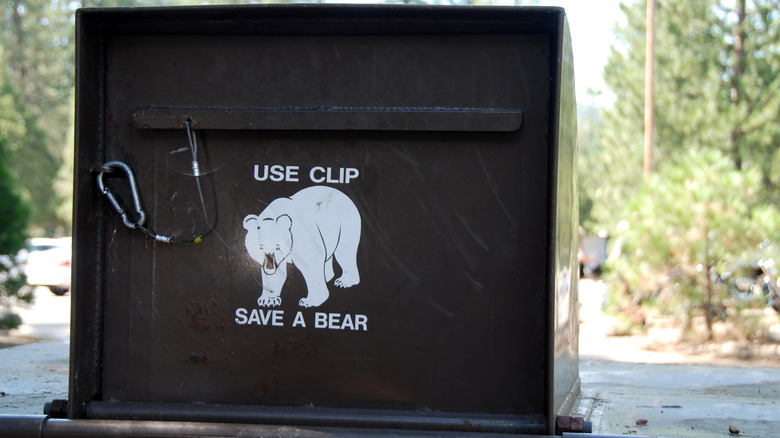
M. Kaercher/Getty Images
Part of the reason why people can’t quite get a restful night’s sleep while camping is due to anxiety. Anything that makes you worry or feel less secure is going to cause restlessness and take away your peace of mind. Camping can be a fairly peaceful experience, and therefore the perfect situation to enjoy the sounds of nature while you fall asleep. However, nature in the form of wild animals can be worrisome if they invade your campsite and create disruptions. The best way to avoid this? Secure your food properly.
Depending on where you’re located, certain regions of the country may have regulations regarding securing your food while camping. This could be due to the presence of bears and wildcats, as well as nocturnal animals like coyotes and skunks. Whatever the case, the best method to keep your campsite safe from hungry creatures is to lock everything away quickly before and after cooking, and especially away from your tent. You should also remove any evidence of food by securing trash away and washing dishes.
Seeing wildlife can make any camping trip go from good to great in a second. That being said, it is always best to keep your distance from a wild animal’s space. Human food is especially unhealthy for wild animals and can make them sick, further disrupting the natural ecosystem of the area. By sticking to a “leave no trace” mentality, you remove any additional stress of attracting animals.
Prepare yourself for bugs before, during and after
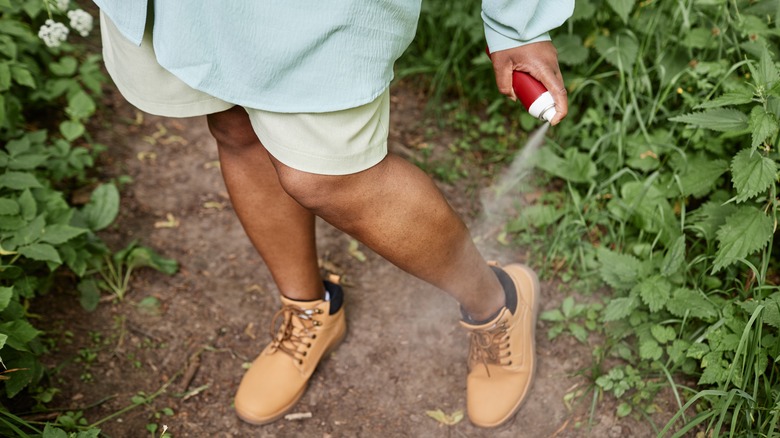
SeventyFour/Shutterstock
Although they might not pose as much of a threat as, say, a bear or a mountain lion, bugs are pests that can also impede your sleep, particularly in greater numbers. No one wants to feel bugs crawling all over them or hear their little buzzing sounds either inside or outside their tent. Luckily, there are plenty of ways to keep the bugs away, as well as methods of preparing to fight against any that come your way.
Packing the right tools to ward off bugs can start your trip off right. Personal items like bug repellent often deter bugs while you’re in motion while wearing proper attire such as long shirts, pants, and socks will also help to keep pests at bay. These can help protect against other nuisance bugs such as midges, biting ants, and especially ticks. Some campers prefer the use of bug zappers as opposed to chemical sprays.
For those who cannot utilize electric sources to run the machines, a campfire is the next best thing. Smoke deters pests like mosquitos and flies without using electricity. To go even further, and similar to animal pests, it is best to keep your campsite cleared of any food or waste. Bugs such as bees and wasps especially love the sugar content of our food and beverages. This also applies to your tent — no matter how much you want a late-night snack.
If you have a wind-down routine, stick to it
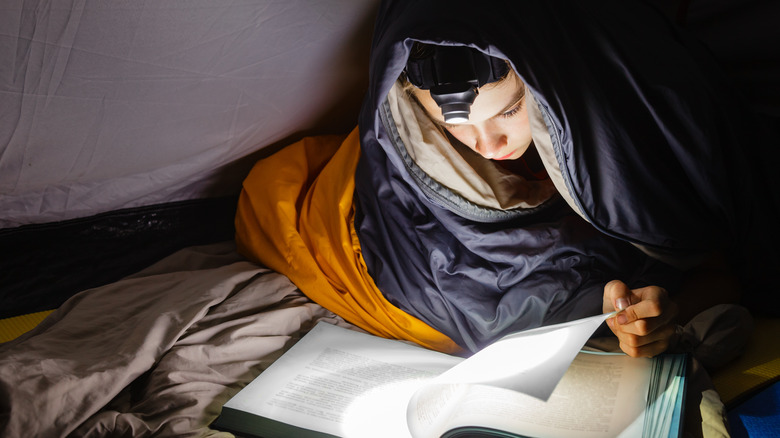
Dmitry Naumov/Shutterstock
As we’ve previously noted, stress and anxiety can often prohibit restful sleep, both at home and elsewhere. One of the best ways to wash away the stress of a day at home is by configuring your ideal wind-down routine. Giving yourself time to power down is crucial. As Dr. Babak Larian, co-founder of MDbio, explained to CNN, this time “allows you to reorganize information and give it a rest from all that information.”
Your wind-down routine helps promote sleep, which will in turn assist your brain in retaining memories. At home, this may consist of following through on a skincare routine, making a mug of calming tea, and reading a book in bed. Keeping to a consistent, normal routine before bed is the perfect way to seamlessly go from a restful at-home sleep experience to a similarly comfortable camping sleep experience.
Your wind-down routine does not have to be complicated, especially if it includes a lot of packed items. Some choice nighttime activities include light yoga, listening to music, and reading, all of which are proven to relax the body and get it prepared for sleep. And while you might feel inclined to check what’s going on in the real world, research recommends cutting off screen time at least 30 minutes before bed.
Practice camping beforehand
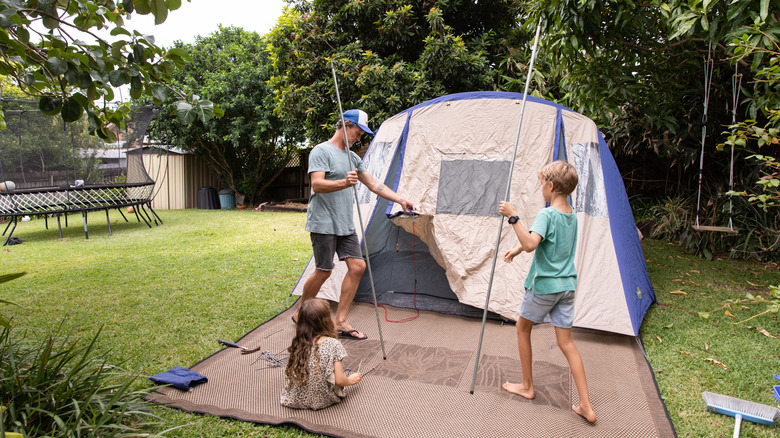
Louise Beaumont/Getty Images
One of the best and most fun ways of ensuring you get a good night’s sleep on a camping trip is to practice at home first. Backyard camping is not new; even as recently as the pandemic people all over the world were using backyard camping as a way to take a break from real life. Camping at home has prevented a lot of future mishaps and mistakes, too. The National Park Service even recommends doing an at-home session of backyard camping just to test out your new gear. While it may seem a bit silly to pack everything up just to unpack it all right outside your house, the practice will give you peace of mind and a better night’s sleep.
Whether you intend to travel in a group or go solo, every camping trip requires a well-thought-out plan, which you can practice crafting on a backyard adventure. Packing for a camping trip, for instance, takes practice, from making sure everything fits in your bags to ensuring you don’t overpack. With practice sessions in the backyard, you can see what gear is most practical, and what’s just extra weight in your pack.
These sessions should also extend to days when the weather is inconsistent. As Danielle Williams, founder of the #DiversifyOutdoors movement, told NPR, “You might check the weather three days before your trip and then the morning of, the conditions could change.” What better way to prepare for the unexpected than from the comfort of your backyard?

